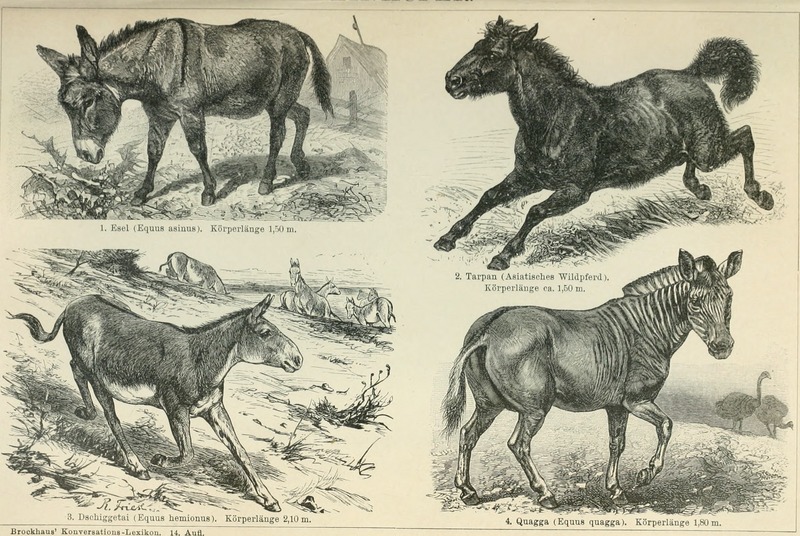|
| Query: tarpan | Result: 4th of 23 | |
African wild donkey (Equus africanus), tarpan or Eurasian wild horse (Equus ferus ferus), Asiatic wild ass or onager (Equus hemionus), quagga (Equus quagga quagga)
| Subject: | African wild donkey (Equus africanus), tarpan or Eurasian wild horse (Equus ferus ferus), Asiatic wild ass or onager (Equus hemionus), quagga (Equus quagga quagga)
| | Poster: | Wiki Photos (---@---.---)
| |

| Resolution: 2512x1684
File Size: 1242824 Bytes
Upload Date: 2017:04:10 15:47:21
|
1. Equus asinus. 1.50m. = African wild ass or African wild donkey (Equus africanus)
2. Tarpan. 1.50m. = Eurasian wild horse (Equus ferus ferus)
3. Equus hemionus. 2.10m = Asiatic wild ass (Equus hemionus)
4. Equus quagga. 1.80m = quagga (Equus quagga quagga)
Title: Brockhaus' Konversations-Lexikon
Year: 1892 (1890s)
Authors:
Subjects: Encyclopedias and dictionaries, German
Source: https://commons.wikimedia.org/wiki/File:Brockhaus%27_Konversations-Lexikon_(1892)_(14594767159).jpg
The African wild ass or African wild donkey (Equus africanus) is a wild member of the horse family, Equidae. This species is believed to be the ancestor of the domestic donkey, which is usually placed within the same species. They live in the deserts and other arid areas of the Horn of Africa, in Eritrea, Ethiopia and Somalia.
The tarpan (Equus ferus ferus), also known as Eurasian wild horse, is an extinct subspecies of wild horse. The last individual believed to be of this subspecies died in captivity in Russia in 1909, although some sources claim that it was not a genuine wild horse due to its resemblance to domesticated horses.
The onager or hemione or Asiatic wild ass (Equus hemionus) is a species of the family Equidae (horse family) native to Asia. Onagers live in deserts and other arid regions of Iran, Pakistan, India, and Mongolia, including in Central Asian hot and cold deserts of Kazakhstan, Uzbekistan, Turkmenistan, and China.
The quagga (Equus quagga quagga) is an extinct subspecies of plains zebra that lived in South Africa until the 19th century. It was long thought to be a distinct species, but genetic studies have shown it to be the southernmost subspecies of plains zebra. It is considered particularly close to Burchell's zebra. Its name was derived from its call, which sounded like "kwa-ha-ha". |
^o^
Animal Pictures Archive for smart phones
^o^
|
|